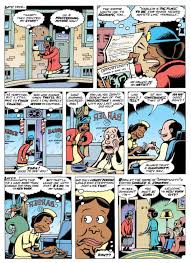Exploring the Fascinating World of Graphic Novel Biographies
Biographies have long been a popular genre in literature, offering readers a glimpse into the lives of remarkable individuals and historical figures. In recent years, graphic novel biographies have emerged as a unique and engaging way to present these stories.
Combining the power of visual storytelling with the depth of biographical narratives, graphic novel biographies provide a fresh perspective on familiar tales. Artists and writers collaborate to bring these stories to life in a visually captivating format that appeals to both avid readers and comic enthusiasts.
One of the key strengths of graphic novel biographies is their ability to humanise historical figures and make their stories more relatable. Through expressive artwork and well-crafted dialogue, readers can connect on a deeper level with the struggles, triumphs, and complexities of these real-life characters.
Moreover, graphic novel biographies often offer a more immersive experience than traditional biographical texts. The combination of visuals and text allows for a multi-dimensional portrayal of events and emotions, creating a rich tapestry that engages the reader on multiple levels.
From iconic figures like Nelson Mandela and Frida Kahlo to lesser-known individuals whose stories deserve to be told, graphic novel biographies celebrate diversity and showcase the vast range of human experiences. They shed light on important moments in history, challenge perceptions, and inspire readers to reflect on their own lives.
Whether you’re a history buff, an art lover, or simply someone who enjoys a good story, graphic novel biographies offer something for everyone. They bridge the gap between art and literature, inviting readers to explore the lives of extraordinary individuals through a visually stunning medium.
So next time you’re looking for a compelling read that combines artistry with storytelling, consider picking up a graphic novel biography. You may find yourself transported to another time and place, gaining new insights into the lives of those who have shaped our world.
Exploring Graphic Novel Biographies: Pioneers, Definitions, and Varieties
- Who is the father of the graphic novel?
- What is a graphic biography?
- What is 1 example of graphic novel?
- What are two types of graphic novels?
Who is the father of the graphic novel?
The question of who is considered the father of the graphic novel is a topic of much debate and discussion within the realm of comic book history. While there isn’t a definitive answer, Will Eisner is often credited with pioneering the concept of the graphic novel with his groundbreaking work, “A Contract with God and Other Tenement Stories,” published in 1978. Eisner’s innovative blending of words and images in a longer-form narrative helped pave the way for the recognition and acceptance of graphic novels as a legitimate form of literature and art. His contributions have had a lasting impact on the medium, influencing generations of artists and writers who continue to push the boundaries of storytelling through sequential art.
What is a graphic biography?
A graphic biography is a dynamic and innovative form of storytelling that blends the visual elements of comics with the narrative depth of traditional biographies. It presents the life story of a real person through the use of illustrations, speech bubbles, and panels, offering a visually engaging and immersive experience for readers. By combining art and text, a graphic biography captures the essence of an individual’s journey, emotions, and impact on history in a compelling and accessible format that appeals to a wide audience.
What is 1 example of graphic novel?
One exemplary graphic novel that stands out in the realm of biographies is “Maus” by Art Spiegelman. This groundbreaking work masterfully intertwines history, memory, and personal narrative to depict the Holocaust through the lens of Spiegelman’s own family history. Through its innovative use of anthropomorphic characters to represent different ethnic groups, “Maus” offers a poignant and thought-provoking exploration of trauma, survival, and intergenerational legacy. It has garnered critical acclaim and accolades, solidifying its place as a seminal work in the genre of graphic novel biographies.
What are two types of graphic novels?
When exploring the world of graphic novels, it’s important to understand that this medium encompasses a diverse range of genres and styles. Two common types of graphic novels are fictional narratives and non-fictional works, such as biographies. Fictional graphic novels often feature imaginative storytelling, fantastical worlds, and fictional characters, offering a creative outlet for artists and writers to craft compelling narratives. On the other hand, non-fiction graphic novels, like biographies, delve into real-life events, historical figures, or personal stories presented through the lens of visual storytelling. Both types of graphic novels have their unique appeal and contribute to the richness and diversity of the medium as a whole.


Leave a Reply